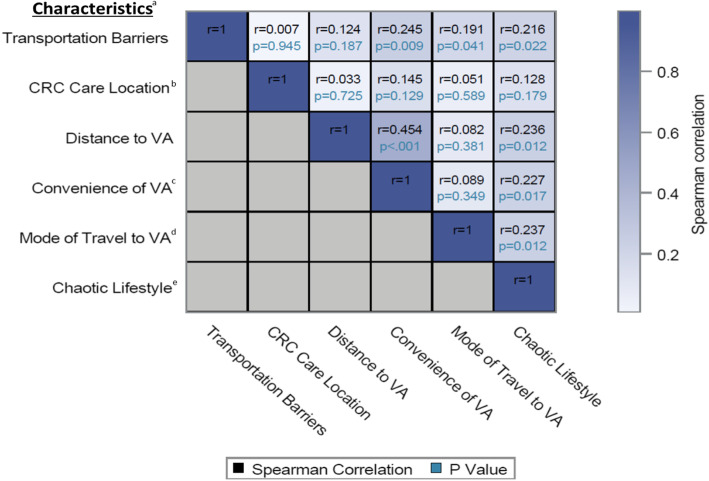Fig. 2.
Relationship Between Transportation-related Factors and Chaotic Lifestyle. Abbreviations: CRC, colorectal cancer care; VA, Veterans Affairs. a SAS was used to calculate Spearman’s correlation coefficients and to create the correlation heatmap. Variables were continuous (chaotic lifestyle) or categorical (transportation barriers: “Always”, “Often”, “Sometimes”, “Never”; distance to the VA: “0 to 20 miles”, “21 to 40 miles”, “41 to 60 miles”, “61 to 80 miles”, “81 to 100 miles”, “101 miles or more”; use of the VA for colorectal cancer care: “All of your cancer care”, “More than half of your cancer care”, “About half of your cancer care”, “Less than half of your cancer care”; convenience of VA: “Very convenient”, “Somewhat convenient”, “Somewhat inconvenient”, “Very convenient”; mode of travel to the VA: “Drive myself’, “Friend or family drives me”, “Health aide”, “Disabled American Veterans (DAV) or other shuttle service”, “Public transportation”, “Another source”). b Participants who did not respond or responded “Don’t know” were excluded from analysis (n = 2). c Participants who did not respond or responded “Don’t know” were excluded from analysis (n = 2). d Mode of travel to the VA is ordered based on decreasing travel independence. Veterans who selected (1) “Drive myself” have access to a vehicle and are in control of traveling to or from the VA as needed; (2) “Friend or family drives me” face some limitations due to others’ availability but are able to tailor transportation to or from the VA according to their needs; (3) “Public transportation” are further limited by fixed travel schedules and routes to or from the VA; or (4) “Another source” are assumed to be the most restricted in terms of travel independence (respondents did not select “Health aide” or “DAV or other shuttle service”). e Participants who did not respond or had missing values were excluded from analysis (n = 3)

